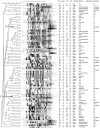Microbiological and Clinical Characteristics of Hypermucoviscous Klebsiella pneumoniae Isolates Associated with Invasive Infections in China
- PMID: 28203549
- PMCID: PMC5286779
- DOI: 10.3389/fcimb.2017.00024
Microbiological and Clinical Characteristics of Hypermucoviscous Klebsiella pneumoniae Isolates Associated with Invasive Infections in China
Abstract
A distinctive syndrome caused by hypermucoviscous Klebsiella pneumoniae (HMKP) including pyogenic liver abscess (PLA) is now becoming a globally emerging disease. In the present study, 22.8% (84/369) of K. pneumoniae clinical isolates associated with various types of invasive infections were identified as HMKP, with 45.2% associated with PLA. Multivariate regression analysis showed that male patients with 41-50 years, PLA, diabetes mellitus, and hypertension were independent risk factors for HMKP infections. K2 (42.9%, 36/84) was the most common capsular serotype among HMKP isolates, followed by K1 (23.8%, 20/84). Seventy-five percentage of K1 HMKP isolates were associated with PLA, while K2 HMKP isolates accounted for more types of invasive infections. The positive rates of iutA, mrkD, aerobactin, iroN, and rmpA among HMKP isolates were significantly higher than those among non-HMKP isolates (p < 0.05). There was a correlation between magA, ybtS, alls, and wcaG and K1 isolates. Interestingly, mrkD was exclusively detected among HMKP (32.1%, 27/84) and K2 isolates (65.9%, 27/41). All K1 and K2 HMKP and non-HMKP isolates were positive for rmpA. Aerobactin was found among 95.0 and 97.5% of K1 and K2 isolates. ST23 was found to be the most prevalent ST among 69 HMKP isolates with K1, K2, K5, K20, and K57 (27.5%, 19/69) and was only found among K1 isolates. ST65 was the second most prevalent ST (26.1%, 18/69) and was also only found among K2 isolates. ST23-K1 HMKP isolates (84.2%, 16/19) were associated with PLA, while ST65-K2 isolates were correlated with more types of infections relative to ST23-K1 isolates. PFGE results showed that the homology of 84 HMKP isolates was diverse. Only five PFGE clusters with more than 75% similarity accounted for more than three isolates. These five PFGE clusters only accounted for 35 (41.7%, 35/84) isolates. In conclusion, our study first found that hypertension and male patients with 41-50 years old were independent risk factors. The composition of ST types and PFGE clusters among K. pneumoniae K2 isolates was more diverse than K1 isolates. K1 and K2 HMKP isolates had respective specific profiles of virulence-associated genes.
Keywords: Klesiella pneumonia; characteristics; epidemiology; hypermucoviscosity.
Figures
References
-
- Brisse S., Fevre C., Passet V., Issenhuth-Jeanjean S., Tournebize R., Diancourt L., et al. . (2009). Virulent clones of Klebsiella pneumoniae: identification and evolutionary scenario based on genomic and phenotypic characterization. PLoS ONE 4:e4982. 10.1371/journal.pone.0004982 - DOI - PMC - PubMed
MeSH terms
Substances
Grants and funding
LinkOut - more resources
Full Text Sources
Other Literature Sources
Research Materials


